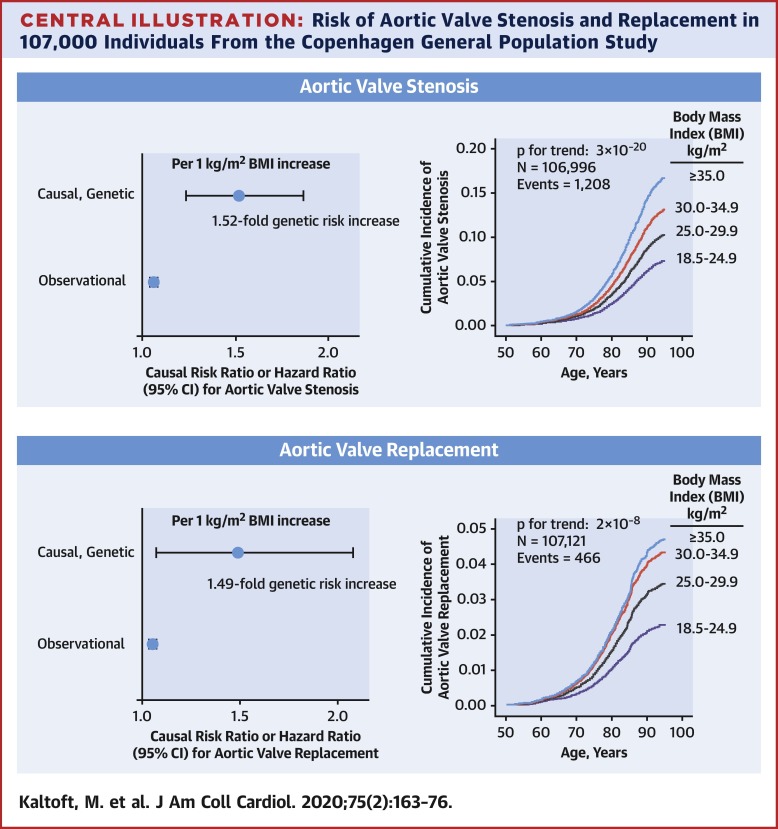当前位置:
X-MOL 学术
›
J. Am. Coll. Cardiol.
›
论文详情
Our official English website, www.x-mol.net, welcomes your
feedback! (Note: you will need to create a separate account there.)
Obesity as a Causal Risk Factor for Aortic Valve Stenosis
Journal of the American College of Cardiology ( IF 21.7 ) Pub Date : 2020-01-01 , DOI: 10.1016/j.jacc.2019.10.050 Morten Kaltoft 1 , Anne Langsted 1 , Børge Grønne Nordestgaard 1
Journal of the American College of Cardiology ( IF 21.7 ) Pub Date : 2020-01-01 , DOI: 10.1016/j.jacc.2019.10.050 Morten Kaltoft 1 , Anne Langsted 1 , Børge Grønne Nordestgaard 1
Affiliation

|
BACKGROUND
Causal risk factors for aortic valve stenosis are poorly understood, limiting the possibility of preventing the most common heart valve disease. OBJECTIVES
The hypothesis was tested that genetically based obesity measured by body mass index is causally associated with risk of aortic valve stenosis and replacement. METHODS
The authors included 108,211 individuals from the Copenhagen General Population Study. Participants had measurements of body mass index, waist-hip ratio, and waist circumference, and information on 5 genetic variants associated with obesity. A Mendelian randomization design was used to investigate genetic and observational associations of obesity with incident aortic valve stenosis (n = 1,215) and replacement (n = 467) for a median follow-up time of 8.7 years. RESULTS
Genetically increased body mass index was causally associated with increased risk of aortic valve stenosis. Compared with an unweighted allele score of 0 to 3, individuals with an allele score 7 to 10 had a mean increase in body mass index of 0.87 kg/m2, and the age and sex-adjusted hazard ratio for aortic valve stenosis was 1.3 (95% confidence interval [CI]: 1.0 to 1.7) for allele score 4, 1.4 (95% CI: 1.1 to 1.8) for allele score 5 to 6, and 1.6 (95% CI: 1.3 to 2.1) for allele score 7 to 10 (p for trend: 9 × 10-5). A 1-kg/m2 increase in body mass index was associated with causal risk ratios for aortic valve stenosis and replacement, respectively, of 1.52 (95% CI: 1.23 to 1.87) and 1.49 (95% CI: 1.07 to 2.08) genetically, and with corresponding hazard ratios of 1.06 (95% CI: 1.05 to 1.08) and 1.06 (95% CI: 1.03 to 1.08) observationally. CONCLUSIONS
Obesity from human genetics was causally associated with higher risk of aortic valve stenosis and replacement.
中文翻译:

肥胖是主动脉瓣狭窄的危险因素
背景对主动脉瓣狭窄的致病危险因素知之甚少,限制了预防最常见的心脏瓣膜疾病的可能性。目的 假设通过体重指数衡量的基于遗传的肥胖与主动脉瓣狭窄和置换的风险存在因果关系。方法 作者包括来自哥本哈根一般人口研究的 108,211 个人。参与者测量了体重指数、腰臀比和腰围,以及与肥胖相关的 5 种遗传变异的信息。孟德尔随机设计用于研究肥胖与主动脉瓣狭窄 (n = 1,215) 和置换 (n = 467) 的遗传和观察关联,中位随访时间为 8.7 年。结果 遗传性体重指数增加与主动脉瓣狭窄风险增加存在因果关系。与未加权的等位基因评分 0 至 3 相比,等位基因评分 7 至 10 的个体体重指数平均增加 0.87 kg/m2,主动脉瓣狭窄的年龄和性别调整风险比为 1.3(95 % 置信区间 [CI]:1.0 至 1.7)等位基因评分 4,1.4(95% CI:1.1 至 1.8)等位基因评分 5 至 6,1.6(95% CI:1.3 至 2.1)等位基因评分 7 至 10 (趋势p:9 × 10-5)。体重指数增加 1 kg/m2 与主动脉瓣狭窄和置换的因果风险比分别为 1.52(95% CI:1.23 至 1.87)和 1.49(95% CI:1.07 至 2.08)。并且相应的风险比为 1.06(95% CI:1.05 至 1.08)和 1.06(95% CI:1.03 至 1.08)。
更新日期:2020-01-01
中文翻译:

肥胖是主动脉瓣狭窄的危险因素
背景对主动脉瓣狭窄的致病危险因素知之甚少,限制了预防最常见的心脏瓣膜疾病的可能性。目的 假设通过体重指数衡量的基于遗传的肥胖与主动脉瓣狭窄和置换的风险存在因果关系。方法 作者包括来自哥本哈根一般人口研究的 108,211 个人。参与者测量了体重指数、腰臀比和腰围,以及与肥胖相关的 5 种遗传变异的信息。孟德尔随机设计用于研究肥胖与主动脉瓣狭窄 (n = 1,215) 和置换 (n = 467) 的遗传和观察关联,中位随访时间为 8.7 年。结果 遗传性体重指数增加与主动脉瓣狭窄风险增加存在因果关系。与未加权的等位基因评分 0 至 3 相比,等位基因评分 7 至 10 的个体体重指数平均增加 0.87 kg/m2,主动脉瓣狭窄的年龄和性别调整风险比为 1.3(95 % 置信区间 [CI]:1.0 至 1.7)等位基因评分 4,1.4(95% CI:1.1 至 1.8)等位基因评分 5 至 6,1.6(95% CI:1.3 至 2.1)等位基因评分 7 至 10 (趋势p:9 × 10-5)。体重指数增加 1 kg/m2 与主动脉瓣狭窄和置换的因果风险比分别为 1.52(95% CI:1.23 至 1.87)和 1.49(95% CI:1.07 至 2.08)。并且相应的风险比为 1.06(95% CI:1.05 至 1.08)和 1.06(95% CI:1.03 至 1.08)。











































 京公网安备 11010802027423号
京公网安备 11010802027423号